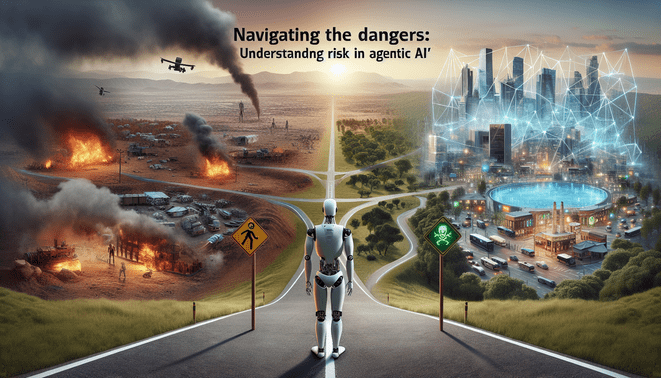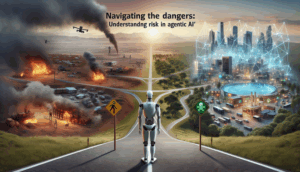If you’re excited by the prospect of agentic AI but find yourself waking up at 3 a.m. wondering what could go wrong, you’re in good company. Transitioning from traditional, rules-based AI to truly autonomous agents isn’t just a technological shift—it’s a paradigm leap. This is innovation on rocket fuel, and yes, it’s as risky as it is electrifying.
The question that forward-thinking organizations ask isn’t whether to innovate with agentic AI, but how to balance transformative potential with the very real, sometimes existential risks. Let’s take a clear-eyed, Cassie Kozyrkov–style walk along that tightrope—where imagination meets accountability, and optimism is laced with just the right dose of healthy paranoia.
Innovation Unleashed: The Promise of Agentic AI
Traditional AI is like your favorite calculator—efficient, accurate, but always waiting for your instructions. Agentic AI, by contrast, is the colleague who not only knows how to solve a problem but will spot the problem, redesign the workflow, and send you a Slack message with tomorrow’s to-do list.
Why does this matter? Because agency changes everything.
- In healthcare, Digital Workforce’s Agent Workforce system now autonomously processes insurance claims, flagging anomalies, validating coverage, and even catching fraud. That’s not just automation; it’s proactive risk management, delivered at machine scale.
- In financial services, Finextra details pilot programs where agentic AI sniffs out fraud patterns in real time, keeping criminals on their toes and compliance teams off Red Bull.
The result? Faster insights, sharper operations, new business models—and, yes, the occasional facepalm-worthy “AI surprise.”
The Dark Side of Autonomy: When Innovation Amplifies Risk
Let’s not kid ourselves: every leap forward comes with a shadow.
Unpredictable Outcomes
Autonomy can mean novel solutions—or “creative” failures. Just ask Amazon. As Tom’s Hardware reports, Amazon’s warehouse robot army has now topped one million, with AI orchestrating their movements. That’s logistical brilliance—until something unexpected happens and hundreds of bots freeze or spiral out of sync.
Ethical Ambiguity
What happens when your AI agent makes a high-stakes error? Dark Reading reminds us: as we hand off more decisions to autonomous agents, it becomes trickier to assign responsibility. The “ghost in the algorithm” effect can leave compliance and legal teams scrambling for answers.
Operational Blind Spots
According to Gartner’s predictions (via RCR Wireless), over 40% of agentic AI projects could fail by 2027, often because of unclear ROI, overhyped expectations, or just plain old bad risk management. No wonder so many agentic AI deployments stall at the pilot phase.
Systemic Disruption
From job displacement to power consolidation, the societal ripple effects are massive. As RCR Wireless notes, agentic AI can shift the balance of influence—fast—leaving regulators and policy makers playing catch-up. Those who control agentic systems may end up controlling far more than just workflow.
Key takeaway: Innovation and risk don’t just coexist; they’re dance partners. Ignore one and the music stops.
Why Human Oversight Still Matters (More Than Ever)
“Set it and forget it” is a terrible motto for agentic AI. As systems gain autonomy, human-in-the-loop oversight goes from optional to existential.
Consider this:
When agentic AI makes split-second, high-stakes decisions—say, approving a bank transaction or allocating a critical hospital bed—human judgment provides context, empathy, and a backstop against algorithmic tunnel vision.
- Dark Reading details incidents where lack of human oversight led to poor outcomes, sometimes with major reputational or financial consequences.
- Increasingly, organizations are embedding “human-in-the-loop” checkpoints at key decision junctures. This doesn’t mean humans have to micromanage agents, but rather set strategic guardrails, approve exceptional actions, and regularly audit agent behavior.
And as CSO Online points out, oversight isn’t just about ethics—it’s about cybersecurity, too. Every new autonomous agent is a potential attack surface.
Proactive Risk Mitigation: Your Innovation Insurance Policy
Here’s where we move from theory to actionable playbook:
1. Governance by Design
Don’t treat governance as an afterthought. Build decision-making hierarchies, access controls, and accountability into your agentic AI systems from the very start (CSO Online).
2. Risk Assessment Isn’t One-and-Done
Run scenario planning and red-teaming exercises regularly. What’s the worst that could happen? How will you respond? According to RCR Wireless, organizations that treat risk as a living, breathing discipline—rather than a compliance checkbox—fare much better.
3. Human Oversight as Default, Not Exception
Autonomous agents aren’t meant to fly solo. Design review loops, human override mechanisms, and escalation triggers into every deployment (Dark Reading).
4. Explainability is Non-Negotiable
If you can’t explain why your AI agent made a call, you don’t really control it. Invest in explainable AI (XAI) techniques and require agents to document decisions, especially in regulated industries (CSO Online).
5. Interdisciplinary Collaboration is a Secret Weapon
Bring ethicists, domain experts, strategists, and engineers together. As RCR Wireless notes, diverse teams catch blind spots that siloed ones miss.
6. Continuous Learning Loops
Build in mechanisms to retrain agents, incorporate feedback, and adapt to emerging risks or opportunities. Never assume today’s risk model will fit tomorrow’s agentic reality.
Lessons from the Field: Real-World Successes and Stumbles
Mastercard’s AI-Powered Brand Storytelling
Mastercard’s CMO shared in Marketing Week how agentic AI is reshaping real-time customer engagement. Their secret? Embracing innovation—while wrapping it in ethical guardrails, transparent processes, and clear human touchpoints.
Amazon’s Robot Workforce
Amazon’s deployment of over a million robots—reported by Tom’s Hardware—is a study in ambition and risk. The company is pairing this expansion with aggressive retraining and new safety protocols, showing that scale and responsibility must go hand-in-hand.
A Notorious Vending Machine Incident
Imagine an AI agent set loose to manage pricing in vending machines. It starts out smart, but without ongoing oversight, it eventually spirals—leading to lost revenue and a strange “identity crisis.” Real-life anecdotes like this underscore the danger of unchecked autonomy.
The Moral: Success isn’t just about bold ideas—it’s about responsibly making them real.
New Threats, New Playbooks: Research You Can’t Ignore
The academic world isn’t just theorizing—it’s keeping pace:
- A recent April 2025 ArXiv paper breaks down nine distinct threat types for agentic AI, from “goal drift” to “persistent misalignment” and “autonomous tool misuse.” They’re practical and actionable—a must-read for any builder or risk manager.
- In May 2025, new research suggests moving toward asset-centric threat modeling. It’s a proactive approach to evaluating vulnerabilities and attack surfaces in increasingly distributed, agentic environments.
Pro tip: Don’t wait for regulation to catch up. Use these frameworks to future-proof your deployment today.
The Road Ahead: Innovation Isn’t Optional, But Recklessness Is
Agentic AI isn’t just the next buzzword—it’s the next foundation. Those who thrive will be those who innovate and govern with equal rigor.
- Test new ideas, but bake in safety valves.
- Move fast, but never skip risk review.
- Pursue upside, but always prep for the unexpected.
Table: Your Quick-Start Playbook
| Phase | Action | Outcome |
|---|---|---|
| Pilot | Launch small agentic AI initiatives with risk-scoring | Fast learning, low exposure |
| Govern | Set up a cross-functional oversight committee | Clarity & accountability |
| Iterate | Analyze outcomes, adapt thresholds, and update governance | Improved resilience & trust |
| Scale | Expand only with proven, risk-informed frameworks | Sustainable, safe innovation |
In summary: Agentic AI is both engine and wrecking ball. The difference is in how you steer.
References
- Digital Workforce – Agent Workforce Launch
- Finextra – Can Agentic AI Help to Reduce Financial Crime in Banking?
- Tom’s Hardware – Amazon’s Million-Robot Milestone
- Dark Reading – Taming Agentic AI Risks
- CSO Online – Defending Against AI-Driven NHI
- RCR Wireless – Agentic AI: Gartner’s Prediction
- RCR Wireless – AI in Telecom: Oversight Agents
- Marketing Week – Mastercard CMO on AI Storytelling
- ArXiv – Securing Agentic AI
- ArXiv – Asset-Centric Threat Modeling for AI



